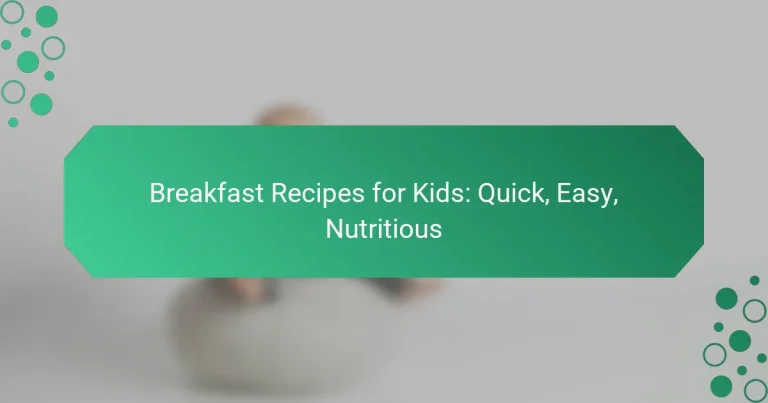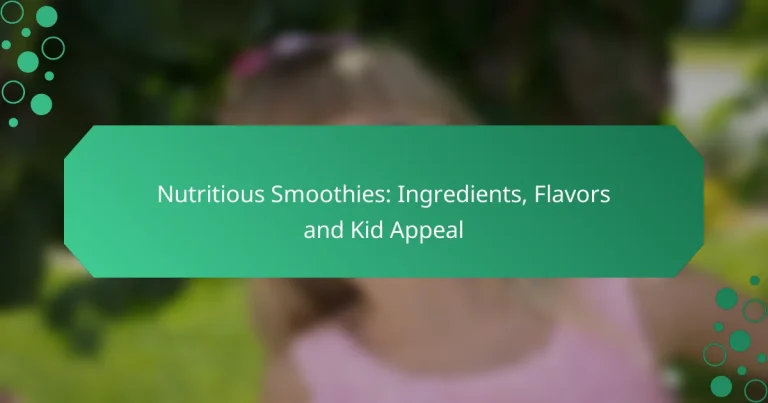Lunchbox Recipes: Kid-Approved, Nutritious and Easy
Discover easy lunchbox recipes that are not only kid-approved but also packed with nutrition. These meals focus on a balanced mix of protein, fruits, and vegetables, ensuring your children enjoy tasty options while receiving essential nutrients. With a variety of wholesome ingredients, you can create satisfying lunches that keep kids energized throughout the day.

What Are Easy Lunchbox Recipes for Kids?
Easy lunchbox recipes for kids are simple, nutritious meals designed to be packed for school or outings. These recipes typically include a balance of protein, fruits, and vegetables, making them appealing and healthy for young eaters.
Peanut Butter and Banana Wrap
This wrap combines the creamy texture of peanut butter with the sweetness of banana, making it a kid-friendly favorite. Spread peanut butter on a whole wheat tortilla, place a banana in the center, and roll it up tightly.
For added nutrition, consider drizzling honey or sprinkling chia seeds before rolling. Cut the wrap into bite-sized pieces for easy handling and a fun presentation.
Mini Pita Pockets with Hummus
Mini pita pockets filled with hummus are a great way to introduce kids to healthy dips. Simply cut mini pitas in half and fill them with hummus, then add sliced cucumbers, carrots, or bell peppers for crunch.
This recipe is versatile; you can use different flavors of hummus, such as roasted red pepper or garlic, to keep things interesting. Pair with a side of fruit for a balanced meal.
Veggie and Cheese Roll-Ups
Veggie and cheese roll-ups are quick to prepare and packed with nutrients. Start with a slice of cheese, add thinly sliced vegetables like bell peppers, carrots, or spinach, and roll them up tightly.
These can be secured with a toothpick for easy eating. Experiment with different cheese varieties, such as cheddar or mozzarella, to find your child’s favorite combination.
Fruit and Yogurt Parfaits
Fruit and yogurt parfaits are a delicious way to incorporate dairy and fruit into lunch. Layer yogurt with fresh fruits like berries, bananas, or peaches in a small container.
Top with granola for added crunch and nutrition. This dish can be prepared the night before, making it a convenient option for busy mornings.
Tortilla Pinwheels
Tortilla pinwheels are fun and easy to make. Spread cream cheese or hummus on a tortilla, add deli meats or veggies, and roll tightly before slicing into pinwheels.
These can be customized with various fillings, such as turkey and spinach or roast beef and cheese. Serve with a side of dipping sauce for extra flavor.

How to Make Nutritious Lunchbox Meals?
Nutritious lunchbox meals can be made by focusing on balanced ingredients that provide energy and essential nutrients. Incorporating whole grains, fresh fruits and vegetables, and lean proteins ensures that kids receive a variety of vitamins and minerals while enjoying their meals.
Incorporate Whole Grains
Whole grains are a vital component of nutritious lunchbox meals as they provide fiber and sustained energy. Options like whole grain bread, brown rice, and quinoa can be easily included in sandwiches, wraps, or salads.
When selecting whole grains, aim for products that list whole grains as the first ingredient. A good rule of thumb is to choose items with at least 3 grams of fiber per serving to maximize health benefits.
Add Fresh Fruits and Vegetables
Fresh fruits and vegetables add essential vitamins, minerals, and antioxidants to lunchbox meals. Including a variety of colors not only enhances nutrition but also makes meals visually appealing to kids.
Consider packing items like carrot sticks, cucumber slices, or apple wedges. Aim for at least one serving of fruit and one serving of vegetables in each lunchbox to promote healthy eating habits.
Include Lean Proteins
Lean proteins are crucial for growth and development in children. Options such as grilled chicken, turkey slices, or plant-based proteins like beans and tofu can be excellent additions to lunchboxes.
When packing proteins, consider portion sizes; aim for about 2-3 ounces per meal. This helps ensure kids receive adequate protein without excessive fat. Avoid processed meats high in sodium and preservatives for healthier choices.

What Are Kid-Approved Ingredients?
Kid-approved ingredients are foods that children enjoy eating while also providing essential nutrients. These ingredients are typically tasty, easy to handle, and can be incorporated into various lunchbox recipes.
Cheese Sticks
Cheese sticks are a popular choice for lunchboxes due to their convenience and nutritional value. They are rich in calcium and protein, making them a filling snack. Look for options that are low in sodium and free from artificial additives.
When selecting cheese sticks, consider portion sizes. A single stick usually contains around 80-100 calories, which is suitable for a snack. Pair them with fruits or vegetables for a balanced meal.
Whole Grain Crackers
Whole grain crackers are an excellent source of fiber and complex carbohydrates, providing sustained energy for kids. They come in various flavors and shapes, making them appealing to children. Opt for brands that list whole grains as the first ingredient and have minimal added sugars.
Serving sizes typically range from 5 to 10 crackers, depending on the brand. Pairing whole grain crackers with cheese or nut butter can create a satisfying and nutritious lunch option.
Nut Butters
Nut butters, such as peanut or almond butter, are nutrient-dense spreads that kids often love. They are high in healthy fats and protein, contributing to satiety and energy levels. Choose natural varieties without added sugars or hydrogenated oils for the healthiest option.
When using nut butters in lunchboxes, consider portion control. A tablespoon is usually enough to spread on whole grain crackers or apple slices. Be mindful of allergies, as some schools have nut-free policies.

How to Plan Lunchbox Recipes for the Week?
Planning lunchbox recipes for the week involves creating a structured menu that balances nutrition and kid-friendly options. By organizing meals in advance, you can save time and ensure your children enjoy a variety of healthy foods.
Create a Weekly Menu
Start by outlining a weekly menu that includes different food groups to ensure balanced nutrition. Aim for a mix of proteins, whole grains, fruits, and vegetables. For example, you might plan chicken wraps, quinoa salads, and fruit cups for the week.
Consider using a template to simplify the process. You can create a chart with each day of the week and fill in lunch options, making it easy to visualize and adjust as needed.
Prep Ingredients in Advance
Preparing ingredients in advance can significantly reduce the time spent on lunchbox assembly each day. Spend a few hours on the weekend chopping vegetables, cooking grains, or portioning snacks into containers.
Store prepped ingredients in clear, labeled containers in the fridge to make assembly quick and straightforward. For instance, having sliced cucumbers and hummus ready to go can make for an easy addition to any lunch.
Involve Kids in the Planning
Involving kids in the lunch planning process can increase their interest in what they eat. Let them choose a few meals or snacks each week, ensuring they feel included and excited about their lunches.
Consider creating a fun activity where kids can pick their favorite fruits or vegetables from a list. This not only makes them more likely to eat what’s packed but also teaches them about healthy choices.

What Are the Benefits of Homemade Lunchboxes?
Homemade lunchboxes offer numerous advantages, including better nutrition, cost savings, and the ability to cater to specific dietary needs. By preparing meals at home, parents can ensure their children receive balanced, healthy options while avoiding processed foods.
Nutrition Control
Homemade lunchboxes allow parents to control the nutritional content of their children’s meals. This means incorporating a variety of fruits, vegetables, whole grains, and lean proteins, which can help meet daily dietary requirements. For instance, including colorful veggies and fruits can provide essential vitamins and minerals.
Additionally, parents can avoid added sugars and unhealthy fats often found in store-bought options. This not only promotes better health but also helps establish healthy eating habits from a young age.
Cost-Effectiveness
Preparing lunchboxes at home is generally more cost-effective than purchasing pre-packaged meals. Ingredients bought in bulk can significantly reduce the overall cost per meal. For example, a homemade sandwich can cost a fraction of a store-bought equivalent.
Moreover, planning meals ahead can minimize food waste, as parents can use leftovers creatively in lunchboxes. This approach not only saves money but also encourages resourcefulness in meal preparation.
Customization and Variety
Homemade lunchboxes can be tailored to suit individual tastes and dietary restrictions. Whether a child is vegetarian, gluten-free, or has food allergies, parents can create meals that cater specifically to their needs. This customization helps ensure that children enjoy their lunches and are more likely to eat them.
Incorporating a variety of foods keeps lunchtime interesting. Parents can rotate different proteins, grains, and snacks to prevent monotony, making each lunch a delightful surprise.
Encouraging Healthy Habits
By involving children in the lunchbox preparation process, parents can teach valuable cooking skills and promote healthy eating habits. Kids can learn about nutrition, portion sizes, and the importance of balanced meals. This hands-on experience can foster a lifelong appreciation for healthy food choices.
Additionally, when children help choose and prepare their lunches, they are more likely to eat what they have made. This engagement can lead to a positive relationship with food and encourage them to try new items.





